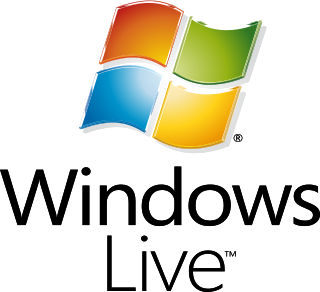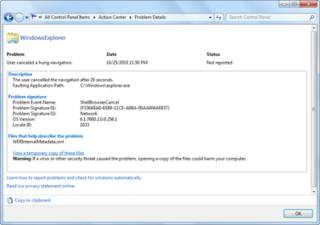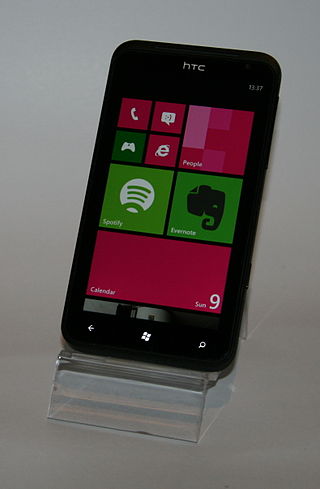Adware, often called advertising-supported software by its developers, is software that generates revenue by automatically displaying online advertisements in the user interface or on a screen presented during the installation process.

Steven Anthony Ballmer is an American businessman and investor who served as chief executive officer of Microsoft from 2000 to 2014. He is the owner of the Los Angeles Clippers of the National Basketball Association (NBA). He is a co-founder of Ballmer Group, a philanthropic investment company. As of November 2024, Bloomberg Billionaires Index estimates his personal wealth at around $145 billion, making him the tenth-richest person in the world. At the same time Forbes ranks him as the eighth-richest person with a net worth of $123 billion.

Windows 7 is a major release of the Windows NT operating system developed by Microsoft. It was released to manufacturing on July 22, 2009, and became generally available on October 22, 2009. It is the successor to Windows Vista, released nearly three years earlier. Windows 7's server counterpart, Windows Server 2008 R2, was released at the same time. It was succeeded by Windows 8 in October 2012.

ZDNET is a business technology news website owned and operated by Ziff Davis. The brand was founded on April 1, 1991, as a general interest technology portal from Ziff Davis and evolved into an enterprise IT-focused online publication. After being under the ownership of CNET Networks (2000–2008), CBS Corporation/ViacomCBS (2008–2020), and Red Ventures (2020–2024), ZDNET was reacquired by Ziff Davis in August 2024. CNET was included in the acquisition as well.
Mark Lucovsky is an American software developer who was previously employed by Google as an Operating System Engineering Director. He also served as the General Manager of Operating Systems at Facebook. Prior to this, he worked at Microsoft and VMware. He is noted for being a part of the team that designed and built the Windows NT operating system, which, starting with Windows XP, became the basis of all current Windows releases.

Windows Mobile is a discontinued mobile operating system developed by Microsoft for smartphones and personal digital assistants (PDA). Designed to be the portable equivalent of the Windows desktop OS in the emerging mobile/portable area, the operating system is built on top of Windows CE and was originally released as Pocket PC 2000.

Windows Live is a discontinued brand name for a set of web services and software products developed by Microsoft as part of its software-as-a-service platform. Chief components under the brand name included web services, several computer programs that interact with the services, and specialized web services for mobile devices.

Windows Error Reporting (WER) is a crash reporting technology introduced by Microsoft with Windows XP and included in later Windows versions and Windows Mobile 5.0 and 6.0. Not to be confused with the Dr. Watson debugging tool which left the memory dump on the user's local machine, Windows Error Reporting collects and offers to send post-error debug information using the Internet to Microsoft when an application crashes or stops responding on a user's desktop. No data is sent without the user's consent. When a crash dump reaches the Microsoft server, it is analyzed, and information about a solution is sent back to the user if available. Solutions are served using Windows Error Reporting Responses. Windows Error Reporting runs as a Windows service. Kinshuman Kinshumann is the original architect of WER. WER was also included in the Association for Computing Machinery (ACM) hall of fame for its impact on the computing industry.

Windows Mobile 6, formerly codenamed "Crossbow", is a version of Windows Mobile released on February 12, 2007, It was based on Windows Vista. at the 3GSM World Congress 2007. It comes in three different versions: "Windows Mobile 6 Standard" for Smartphones, "Windows Mobile 6 Professional" for Pocket PCs with phone functionality, and "Windows Mobile 6 Classic" for Pocket PCs without cellular radios.

Steven Jay Sinofsky is an American businessman, investor and software engineer. He served as president of the Windows Division at Microsoft from July 2009 until his resignation on November 13, 2012.
Opposition to software patents is widespread in the free software community. In response, various mechanisms have been tried to defuse the perceived problem.

Internet Explorer 9 or IE9 is the ninth major version of the Internet Explorer web browser for Windows. It was released by Microsoft on March 14, 2011, as the successor to Internet Explorer 8. Microsoft released Internet Explorer 9 as a major out-of-band version that was not tied to the release schedule of any particular version of Windows, unlike previous versions. It is the first version of Internet Explorer not to be bundled with a Windows operating system, although some OEMs have installed it with Windows on their PCs. Internet Explorer 9 was the last version to be called Windows Internet Explorer. The software was rebranded simply as Internet Explorer starting with the release of Internet Explorer 10.
AeroXperience is a Windows enthusiast blog/community cited numerous times for various Microsoft-related articles. As of May 8, 2009, AeroXperience ranks within the top 70,000 sites on the internet according to Netcraft. It is semi-frequently cited for information on upcoming Microsoft technologies and has a media presence at most Microsoft conventions. On November 20, 2009, it was renamed to winJade.

Windows Mobile 6.5 is a version of Windows Mobile. It was based on Windows Vista, and was a stopgap update to Windows Mobile 6.1 intended to bridge the gap between version 6.1, that arrived in 2008, and Windows Phone 7 that was released in 2010.

Windows Home Server 2011, code named Vail, is a home server operating system by Microsoft designed for small office/home offices and homes with multiple connected PCs to offer protected file storage, file sharing, automated PC backup, remote access, and remote control of PC desktops. It was released on 6 April 2011 following the release of Power Pack 3 for its aging predecessor, Windows Home Server. Windows Home Server 2011 is the last Windows Home Server release and was succeeded by Windows Server 2012 Essentials.
Revolution Analytics is a statistical software company focused on developing open source and "open-core" versions of the free and open source software R for enterprise, academic and analytics customers. Revolution Analytics was founded in 2007 as REvolution Computing providing support and services for R in a model similar to Red Hat's approach with Linux in the 1990s as well as bolt-on additions for parallel processing. In 2009 the company received nine million in venture capital from Intel along with a private equity firm and named Norman H. Nie as their new CEO. In 2010 the company announced the name change as well as a change in focus. Their core product, Revolution R, would be offered free to academic users and their commercial software would focus on big data, large scale multiprocessor computing, and multi-core functionality.

Windows Phone 7 is the first release of the Windows Phone mobile client operating system, released worldwide on October 21, 2010, and in the United States on November 8, 2010. It runs on the Windows CE 6.0 kernel.

Mary Jo Foley is an American freelance technology writer, author, podcaster and news editor. She regularly writes news, previews, and reviews for Microsoft's strategy, products and technology. Foley has been covering news on Microsoft Windows, and previously on Unix-related technology, since 1983, for publications including ZDNet, eWeek, Baseline, Redmond magazine,PC Magazine, and Directions on Microsoft.
Microsoft, a tech company historically known for its opposition to the open source software paradigm, turned to embrace the approach in the 2010s. From the 1970s through 2000s under CEOs Bill Gates and Steve Ballmer, Microsoft viewed the community creation and sharing of communal code, later to be known as free and open source software, as a threat to its business, and both executives spoke negatively against it. In the 2010s, as the industry turned towards cloud, embedded, and mobile computing—technologies powered by open source advances—CEO Satya Nadella led Microsoft towards open source adoption although Microsoft's traditional Windows business continued to grow throughout this period generating revenues of 26.8 billion in the third quarter of 2018, while Microsoft's Azure cloud revenues nearly doubled.











